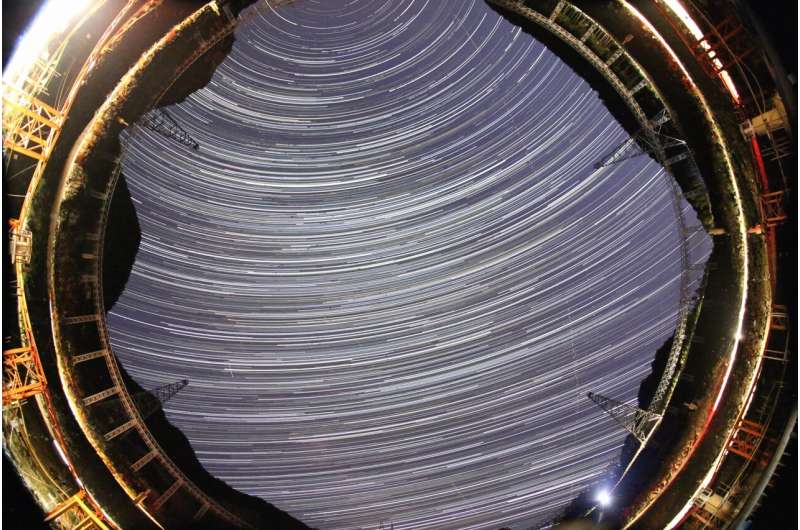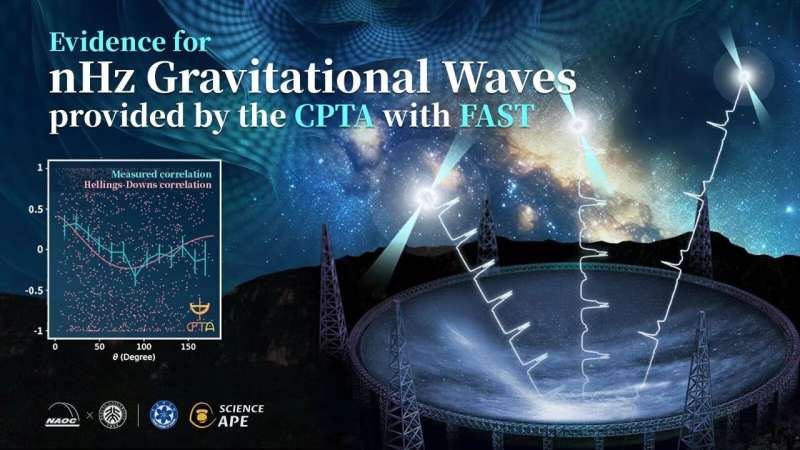This article has been reviewed according to Science X's editorial process and policies. Editors have highlighted the following attributes while ensuring the content's credibility:
fact-checked
trusted source
proofread
Scientists find key evidence for existence of nanohertz gravitational waves

A group of Chinese scientists has recently found key evidence for the existence of nanohertz gravitational waves, marking a new era in nanohertz gravitational wave research. The research was based on pulsar timing observations carried out with the Five-hundred-meter Aperture Spherical radio Telescope (FAST).
The research was conducted by the Chinese Pulsar Timing Array (CPTA) collaboration, which comprises researchers from the National Astronomical Observatories of the Chinese Academy of Sciences (NAOC) and other institutes. Their findings were published online June 28 in the journal Research in Astronomy and Astrophysics (RAA).
Other international pulsar timing array collaborations will announce similar results in the same day.
Acceleration of massive objects disturbs the surrounding space-time and produces "ripples," i.e., gravitational waves. Although such wave signals are extremely weak, they offer a direct method for probing masses that do not emit light. For this reason, astronomers have long aimed to use gravitational waves to aid in understanding the formation of the universe's structures and investigating the growth, evolution, and merger of the most massive celestial objects in the universe, that is, supermassive black holes. Such research will also help physicists gain insight into the fundamental physical laws of space-time.
Taking advantage of FAST's high sensitivity, the CPTA research team monitored 57 millisecond pulsars with regular cadences for 41 months. The team found key evidence for quadrupole correlation signatures compatible with the prediction of nanohertz gravitational waves at a 4.6-sigma statistical confidence level (with a false alarm probability of two in a million).
The team used independently developed data analysis software and data processing algorithms to achieve its breakthrough at the same time as other international groups. Independent data processing pipelines produced compatible results.
The time span of CPTA data set is relative shorter at present. However, due to the high sensitivity of FAST telescope, CPTA achieved similar sensitivity comparing to other PTAs. The future observations will soon extend the span of CPTA data and help in identifying the astronomical sources of current signal.
Objects of greater mass produce gravitational waves of lower frequency. For example, the most massive celestial body in the universe, the supermassive black hole binaries (with 100 million to 100 billion times the solar mass) in the center of galaxies, mainly generate gravitational waves in the nanohertz band, with corresponding signal time scales from years to decades. This frequency band also includes gravitational wave contributions from processes of the early universe as well as exotic objects such as cosmic strings.

Using nanohertz gravitational waves in cosmic observation is thus hugely important in studying key problems in contemporary astrophysics such as supermassive black holes, the history of galaxy mergers, and the formation of large-scale structures in the universe.
Detection of nanohertz gravitational waves is very challenging, though, due to their extremely low frequency, where the corresponding period can be as long as several years and wavelengths up to several light-years. So far, long-term timing observation of millisecond pulsars with extreme rotational stability is the only known method for effectively detecting nanohertz gravitational waves.
Hunting for these waves is one of the major focuses of present-day physics and astronomy. Regional pulsar timing array collaborations, including the North American Nanohertz Observatory for Gravitational Waves (NANOGrav), the European Pulsar Timing Array (EPTA), and the Australian Parkes Pulsar Timing Array (PPTA), have been collecting pulsar timing data for more than 20 years, with the aim of detecting nanohertz gravitational waves. Recently, several new regional collaborations have also joined this field, including CPTA, the India Pulsar Timing Array (InPTA), and the South Africa Pulsar Timing Array (SAPTA).
The detection sensitivity of pulsar timing arrays to nanohertz gravitational waves strongly depends on the observational time span—that is, sensitivity grows rapidly with the increase in observational time span. The current CPTA's observational time span is shorter, which makes it easier to effectively increase the time span, e.g. observing for another 41 months will double the time span.
In the future, these regional collaborations will promote international pulsar timing array collaboration and expand exploration of the universe through nanohertz gravitational wave observations.
More information: Heng Xu et al, Searching for the Nano-Hertz Stochastic Gravitational Wave Background with the Chinese Pulsar Timing Array Data Release I, Research in Astronomy and Astrophysics (2023). DOI: 10.1088/1674-4527/acdfa5
Provided by Chinese Academy of Sciences





















